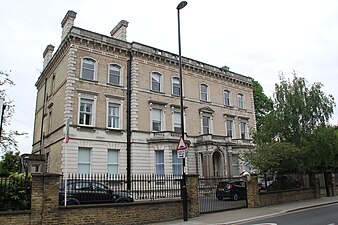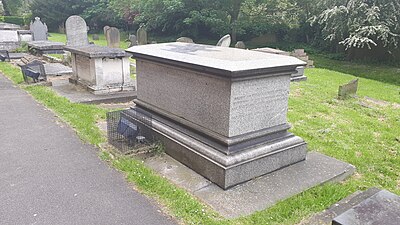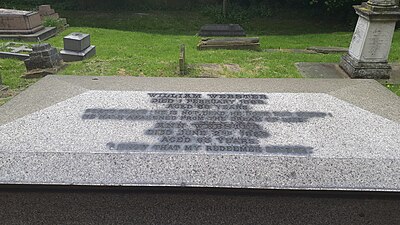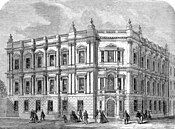William Webster (builder)
William Webster | |
|---|---|
| Born | May 1819 Wyberton, England |
| Died | 1 February 1888 (aged 68) London, England |
| Nationality | British |
| Known for |
|
William Webster (May 1819 – 1 February 1888) was a British builder who worked with architects and engineers such as Gilbert Scott and Joseph Bazalgette and is especially associated with several embankments of the River Thames.[1]
Career
[edit]
Born in the small Lincolnshire village of Wyberton in 1819, Webster apprenticed to the Boston, Lincolnshire builder Mr. Jackson. Immediately following his apprenticeship, Webster became a builder in Wyberton and was initially involved in the refurbishment and renovation of a number of churches in Lincolnshire (working with Sir Gilbert Scott on Algakirk church) and the surrounding counties as well the building of Boston's Exchange Building.
Between 1856 and 1857, Webster was commissioned to build the Cambridge Lunatic Asylum at Fulbourn. Following the completion of this project his next was the building of the Three Counties Asylum, near Hitchin.
Moving to London in 1860, his first projects in the capital included contracts for the Crossness Southern Outfall Sewer,[2] Abbey Mills Pumping Station and the Western Pumping Station (adjacent to the Grosvenor Canal in Pimlico). He then moved to constructing parts of the Victoria Embankment and the whole of the Albert and Chelsea Embankments (1871)[3][4] as well as an extension to the embankment around the Houses of Parliament. He was also involved in the Holborn Viaduct railway station[5] and hotel, and the southern approaches to Tower Bridge.[6] His company also undertook many other contracts including building chapels - for example, the Dissenters' Chapel in Hither Green Cemetery.[7]
Webster died at his residence, Wyberton House (built, probably to his own design, by his firm and completed in 1869),[8] in Lee, London on 1 February 1888, and was interred at St Margaret's, Lee.
Legacy
[edit]After Webster's death, his firm was continued for some years by his son, also called William,[9] a chemical engineer. Some sources suggest the company's work included construction of Blackheath Halls[10] though this may reflect his son's involvement in funding the project, as other sources attribute the construction to a J.O. Richardson of Peckham.[11]
Gallery
[edit]-
Wyberton House
-
Webster's grave
-
Grave inscription
Notable works
[edit]- Crossness Pumping Station (1865)
- Albert Embankment (1869)
- Victoria Embankment (1870)
- Chelsea Embankment (1874)
- Blackheath Halls
See also
[edit]References
[edit]- ^ "Obituary. William Webster, 1819-1888". Minutes of the Proceedings of the Institution of Civil Engineers. 92 (1888). Institution of Civil Engineers: 410–411. 1888. doi:10.1680/imotp.1888.20967.
- ^ "London Borough of Bexley - Crossness".
- ^ "Kensington Chelsea Thames Conservation Area Proposals Statement". Royal Borough of Kensington and Chelsea. Retrieved 8 March 2016.
- ^ "Chelsea Embankment Gardens". London Gardens Online. Retrieved 8 March 2016.
- ^ "Construction of Snow Hill station (Messrs William Webster), contractor's account". National Archives. Retrieved 8 March 2016.
- ^ "Tower Bridge". Engineering Timelines. Retrieved 8 March 2016.
- ^ "Dissenters Chapel designed by William Webster for the Hither Green Cemetery, Verdant Lane, London SE6". The Victorian Web. Retrieved 8 March 2016.
- ^ "Historic Walk in Blackheath - section "Nos 7+ 9 Lee Terrace (Wyberton House )"". London Open House. Retrieved 8 March 2016.
- ^ "William Webster – A Victorian Building & Civil Engineering Contractor". Running Past. Retrieved 13 May 2018.
- ^ "Blackheath Halls, Grade II* Listed Victorian Performance Halls". Fanshawe. Retrieved 8 March 2016.
- ^ "William Webster". The Blackheath Society. Retrieved 14 May 2018.
Text is available under the CC BY-SA 4.0 license; additional terms may apply.
Images, videos and audio are available under their respective licenses.




